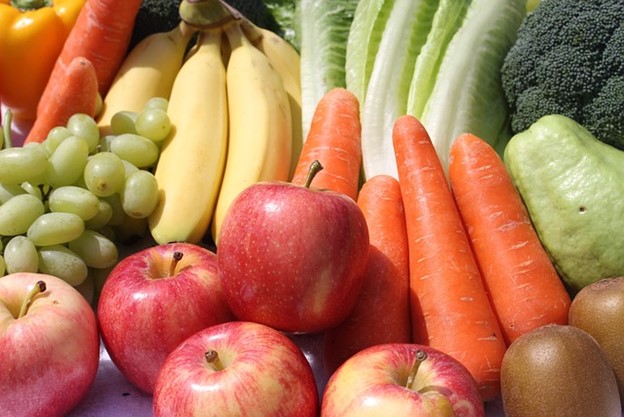Written by: Kristen DiFilippo, PhD, RDN
The Dietary Guidelines for Americans recommend the consumption of a variety of vegetables and fruits (USDA and US Department of Health and Human Services, 2020). Only 12.3% of adults consume enough fruit, and even fewer, 10%, meet the vegetable recommendations (Lee, et al., 2019). For children one to five years old, almost 1 in 3 do not eat fruit daily and nearly half do not eat vegetables daily (Hamner, et al., 2023). Special Supplemental Nutrition Program for Women, Infants, and Children (WIC) recently announced that it will be increasing the cash-value benefit for fruits and vegetables for children to $26 for children, $47 for pregnant and postpartum, and $52 for breastfeeding. This change aims to support pregnant, post-partum, and breastfeeding adults and young children in meeting their fruit and vegetable needs.
Recommendations
People are recommended to consume a variety of vegetables that are raw or cooked, fresh, frozen, canned, or dried. For variety, it is important to select vegetables that are dark green; red, and orange; beans, peas, and lentils; starchy; and more to get a variety of nutrients. Fruit can be whole, cut, mashed, cooked, or 100% juice with a recommendation that less than half of the fruit consumed comes from 100% juice. Getting enough vegetables and fruit helps to reduce risks for many diseases including heart disease and certain types of cancers.
According to MyPlate.gov, the following amounts of fruits and vegetables are recommended per day:
- Toddlers:
- 12-23 months: 2/3 to 1 cup of vegetables, ½ to 1 cup of fruit
- Children
- 2-3 years: 1 to 1 ½ cup of vegetables, 1 to 1 ½ cup of fruit
- 4-8 years: 1 ½ to 2 ½ cups vegetables, 1 to 2 cups fruit
- Girls
- 9-12 years: 1 ½ to 3 cups vegetables, 1 ½ to 2 cups fruit
- 14-18 years: 2 ½ to 3 cups vegetables, 1 ½ to 2 cups fruit
- Boys
- 9-13 years: 2 to 3 ½ cups vegetables, 1 ½ to 2 cups
- 14-18 years: 2 ½ to 4 cups vegetables, 2 to 2 ½ cups
- Women
- 19-30 years: 2 ½ to 3 cups vegetables, 1 ½ to 2 cups fruit
- 31-59 years: 2 to 3 cups vegetables, 1 ½ to 2 cups fruit
- 60+ years: 2 to 3 cups vegetables, 1 ½ to 2 cups fruit
- Men
- 19-30 years: 3 to 4 cups vegetables, 2 to 2 ½ cups fruit
- 31-59 years: 3 to 4 cups vegetables, 2 to 2 ½ cups fruit
- 60+ years: 2 ½ to 3 ½ cups vegetables, 2 cups fruit
Shopping Tips
The USDA has 3 budget-friendly tips for increasing fruits and vegetables (USDA, 2020).
- Plan before you shop. This will help you to buy only what you need and avoid food waste.
- Choose low-cost recipes. Selecting fruits and vegetables that are in season is a great way to decrease costs. Buying in bulk can also help reduce costs if you can plan recipes to use up the amount you’ve purchased.
- Go beyond fresh produce. Frozen and canned produce can be great options for keeping food costs down and helping you meet your fruit and vegetable goals.
Many Americans are not meeting their needs for fruits and vegetables. Increasing fruit and vegetable intake can help to reduce disease risk. It can also help people to reduce overall calorie intake while ensuring adequate nutrients. The increased WIC benefits will help an at-risk population to access more fruits and vegetables. Nutrition professionals can also help by assessing intake and providing budget-friendly strategies for increasing intake.
References
Lee SH, Moore LV, Park S, Harris DM, Blanck HM. Adults Meeting Fruit and Vegetable Intake Recommendations — United States, 2019. MMWR Morb Mortal Wkly Rep 2022;71:1–9. DOI: http://dx.doi.org/10.15585/mmwr.mm7101a1external icon.
U.S. Department of Agriculture and U.S. Department of Health and Human Services. Dietary Guidelines for Americans, 2020-2025. 9th Edition. December 2020. Available at DietaryGuidelines.gov.
Hamner, H. C., Dooyema, C. A., Blanck, H. M., Flores-Ayala, R., Jones, J. R., Ghandour, R. M., & Petersen, R. Fruit, Vegetable , and Sugar-Sweetened Beverage Intake Among Young Children, by State-United States, 2021.. MMWR Morb Mortal Wkly Rep 2023;72:1-6.
U.S Department of Agriculture. (2020). How to Save More on Fruits and Vegetables. https://www.usda.gov/media/blog/2020/05/29/how-save-more-fruits-and-vegetables
Image from Pixabay.













